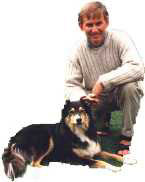Common Health Problems affecting Dogs and CatsVeterinary advice from John Burns BVMS MRCVS |
|Home
| Introduction
|Natural Pet Health
Care |Development of disease
|Pet Health Management|
Common
Pet Health Problems
| FAQ | Factsheets |
What's on the site? | Contact
JOHN BURNS' PET HEALTH MANAGEMENT PROGRAMME
If the right conditions are present the body can heal itself and this Pet Health Management Programme provides those conditions. We are harnessing the innate healing abilities of the body in order to achieve a proper, long-lasting cure.
1 Gradually change to the chosen trial food. Slow introduction allows a smooth change of intestinal bacteria, thus minimising the risk of intestinal upset. 2 Following the introductory period the trial food should be the only food given 3 Quantity of food must be carefully controlled to meet but not exceed the dog's requirements. (See below) 4 Regular suitable exercise helps to use up excess calories, discharge waste products, improve circulation and provides mental stimulation. 5 Ask your veterinary surgeon to empty the dog's anal glands. This aids in the elimination of wastes from the system. 6 All family members must cooperate by ensuring that no extras (titbits, treats, table scraps or other foods are given. This Management Programme has to be tailored to the needs of the individual because there are so many individuals whose differing needs have to be accommodated. It is not enough to try the diet and hope for the best.
GETTING IT RIGHTGetting the quantity of food right depends taking account of individual variations viz. THE FUSSY EATER Feed once daily, usually 5 -7 p.m.. Offer less than the recommended amount for the dog's weight e.g. if the dog weighs 20 kg offer 5-6 ounces (125 - 150gr ) rather than 8 ounces (200 gr.) Any food not consumed within 10 - 15 minutes should be taken up and no more food offered until the same meal-time next day. At the next meal, offer slightly less than the amount eaten the day before. Experiment with quantities until you ensure that your dog is READY for its meal each day, consumes the whole amount and would even eat a little more if it were available. After the first few days, if you have to offer extras to encourage your dog to eat then your are probably overfeeding. THE "HUNGRY" OR "GREEDY" DOG. With these dogs, appetite is NOT a reliable guide to requirements. Offer the prescribed maximum according to weight. This can be given as one feed or split between two feeds depending on preference and the amount can then be adjusted depending on results. Special ConsiderationsWhat if the dog won't eat? Some older dogs may be underweight yet have poor appetite due to loss of sense of smell and taste. These dogs can be encouraged to eat by e.g. more frequent meals, handfeeding, adding some home-made food, warm water or vegetable stock to the food to increase palatability. The anorexic dog Some dogs will not eat due to stress. This applies particularly to the dog with a timid or nervous disposition. Initially they may benefit from handfeeding several times daily. If possible, eliminate the cause of the stress. But too much effort towards getting the dog to eat will itself cause stress to dog (and owner) and perpetuate the problem. The show dog "Show condition" often requires that the dog should have lots of "body". In this case "body" usually means "fat" not muscle and judges tend to pick fat dogs rather than healthy lean dogs. Many owners of show dogs complain that they cannot get the dog to eat enough to achieve the necessary "body".. This is because the dog is eating enough to satisfy its own needs but not enough to get the dog fat enough for the show ring. Dogs with digestive problems If your dog is underweight as a result of poor absorption of food there is a strong temptation to increase the food to build the dog up. But it is better to proceed cautiously in order to avoid any setbacks. An occasional hard-boiled egg can be a useful supplement. When changing to Burns you can expect to see normal stools within a short time. But the intestines may need several weeks of correct feeding before regaining their efficiency. Increasing the food intake reduces the efficiency of absorption. Changing Food Choose a food
which is low in protein and fat but high in complex carbohydrate.
This tends to produce a lean, fit condition so one would expect
a slightly overweight dog to slim down. Most dogs can change to
a food such as this over the space of a few days. However, a small
percentage of dogs who are changing from a diet high in protein,
fat and sugars (the "normal" dog foods) lose too much
weight and become bony. If this happens, the solution is NOT to
increase the amount of
Common pet health problems |
John Burns can be
contacted at 99 Ferry Road, Kidwelly, Carmarthenshire, Wales, SA17 5EJ -
Tel 01554 890482 | Fax 01554 891476 |
email nutritional advice
©2006 John Burns. No part of this website can be reproduced in any
form without the express permission of John Burns BVMS Lic Ac.MRCVS -
Legal notice
 You
may wonder why a single Pet Health Management Programme could
be suitable for all sorts of health problems and illnesses. The
answer lies at the root of Holistic Medicine, the principles of
which are described in the Introduction.
You
may wonder why a single Pet Health Management Programme could
be suitable for all sorts of health problems and illnesses. The
answer lies at the root of Holistic Medicine, the principles of
which are described in the Introduction.